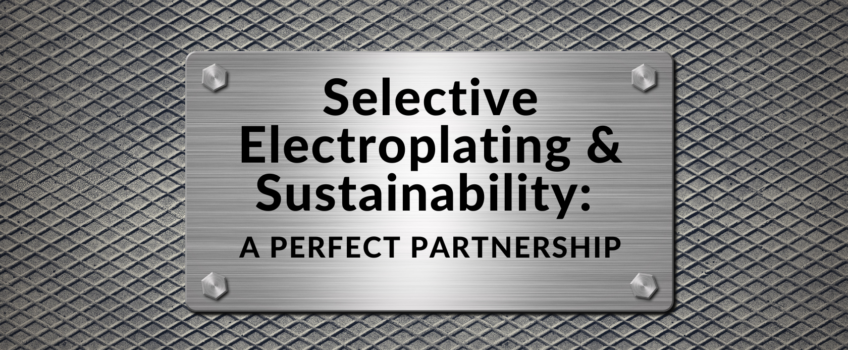
In the sophisticated world of engineering, particularly in the realm of electric motors that are the lifeline of various industries, innovation and efficiency are paramount. Selective electroplating has remarkably ascended as an unsung hero in this domain. Below, we unveil the manifold benefits and intrinsic values that this technique harbours, casting a spotlight on its indispensability.
Precision and Efficiency: The Cornerstones of Selective Electroplating
Electric motors are indispensable, functioning as the backbone in myriad sectors including automotive and manufacturing. However, like all machinery, wear and tear is inevitable. This is where the art and science of selective electroplating shine brightly. Rather than a blanket approach, this technique zeroes in on the specific areas of wear, depositing metal meticulously to restore and rejuvenate the affected components.
This targeted application not only breathes new life into the components but also ensures that the innate architecture and integrity of the parts remain unaltered. The genius of selective electroplating lies in its ability to marry precision with efficiency, a union that yields reduced downtime and augmented productivity.
How Does Electroplating Work?
Electroplating is a fascinating process, integral in various industries for enhancing the properties of metallic surfaces. From improving the aesthetic appeal of jewellery to increasing the corrosion resistance of industrial machinery, electroplating is a versatile and essential technique. But, how exactly does this process work? Let’s delve into the intricate world of electroplating.
The Fundamental Principles
At its core, electroplating involves depositing a layer of metal onto the surface of a substrate, usually made of another type of metal or a conductive material. This transformation is achieved through an electrochemical process in which electrical current is used to reduce cations of the desired plating metal and deposit them onto the substrate.
The Electroplating Process – Step by Step
1. Preparation of the Substrate:
The object to be plated undergoes a meticulous cleaning process to remove any contaminants, oils, or dirt. This ensures optimal adhesion of the plated metal to the surface.
2. Selection of the Appropriate Electrolyte:
An electrolyte solution containing the metal ions of the plating metal is prepared. This solution serves as a medium for the movement of ions during the electroplating process.
3. Submersion of the Substrate:
The cleaned substrate is immersed into the electrolyte solution and connected to the negative terminal of a power source, becoming the cathode.
4. Insertion of the Anode:
An anode, typically made of the plating metal, is inserted into the electrolyte solution and connected to the positive terminal of the power source.
5. Application of Electrical Current:
A direct current is passed through the circuit. Positive metal ions from the anode and the electrolyte solution are attracted to the negatively charged substrate.
6. Deposition of the Metal:
As the metal ions reach the substrate, they gain electrons (are reduced) and form a thin, adherent metal layer on the surface of the substrate.
Selective Electroplating: A Sustainable Choice for Industrial Brilliance
In an era where sustainability is not just a buzzword but a critical element of industrial excellence, selective electroplating emerges as a champion. By focusing the application of metal on worn sections, the consumption of materials is drastically reduced. This not only curtails waste but amplifies the environmental friendliness of the process.
Moreover, in the industrial landscape where downtime is the antithesis of productivity, the swiftness and precision of selective electroplating ensure that operations are resumed in record time, heralding a new dawn of operational efficiency and sustainability.
Mastering the Art of Selective Electroplating
The finesse required in this process is underscored by the need for specialised training. The process is an amalgamation of art and technology, necessitating a skillset that combines technical prowess with a nuanced understanding of the intricate dynamics involved.
Operators are armed with comprehensive training programmes that provide them with theoretical and practical insights. The aim is not just to impart knowledge but to hone expertise that transforms every process of selective electroplating into a masterpiece of precision and efficiency.
While selective electroplating is hailed for its precision, its versatility is often unsung. Traditional repair and replacement methodologies often falter when confronted with intricate geometries and complex configurations. Selective electroplating, with its focused application, navigates these complexities beautifully, ensuring that every nook and cranny is addressed with precision.
The Future of Electric Motor Maintenance
With electric motors propelling industries into the future, maintenance methodologies that are efficient, precise, and sustainable are not just desirable but essential. Selective electroplating doesn’t just tick these boxes but embellishes the maintenance landscape with attributes that are revolutionary.
Every stroke of metal deposited is a testament to precision, every component revitalised underscores efficiency, and every process executed mirrors the future of industrial sustainability and excellence. In the realm of electric motor maintenance, electroplating isn’t just a technique; it is the touchstone of innovation, efficiency, and unrivalled excellence.
Recommended: Sliver Plating, Busbars and Specialist Coatings
In Conclusion
At our engineering firm, we don’t just witness the marvel of selective electroplating; we are avid practitioners, constantly pushing the boundaries of innovation and precision. Our commitment is echoed in every component revitalised, every machine rejuvenated, and every client satisfied. In the evolving narrative of electric motor maintenance, we are not just spectators but active contributors, weaving a tapestry of efficiency, precision, and sustainability that will propel industries into a future where excellence is not just sought but is inherently ingrained.


 Mail:
Mail: 



